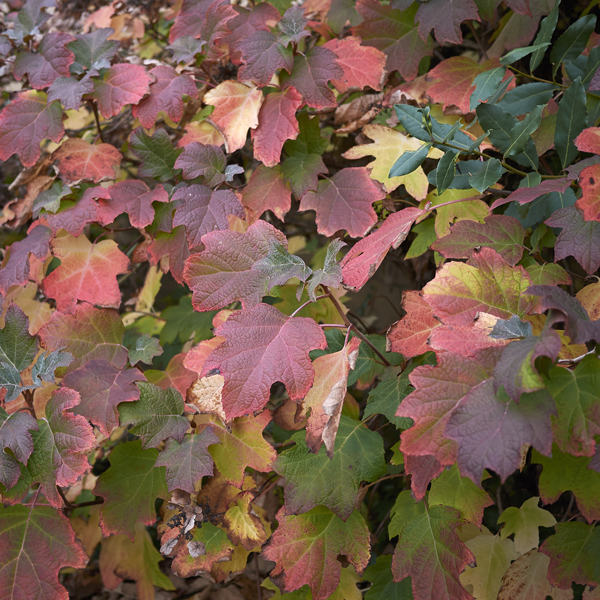
By R. Wayne Mezitt
With dozens of varieties and cultivars readily available at garden centers, hydrangeas continue to be rightfully among the most popular choices for gardens in this region. Most of us immediately envision the hydrangea that’s commonly considered the “signature Cape Cod” landscape plant: the blue-flowering mop-head hydrangea (H. macrophylla); in recent years ‘Endless Summer’ has become the most frequently chosen cultivar. Sadly, as attractive as these mop-head cultivars can be in the right conditions, some years they disappoint us with fewer flowers than we want, challenged by New England’s winter weather extremes.
Although they lack those distinctive blue flowers, oakleaf hydrangea (H. quercifolia) and its cultivars offer many attributes to add year-round appeal to your garden. Oakleaf hydrangea, one of only two species native to the USA (the other is H. arborescens), blooms reliably into Zone 5. Its cone-shaped white flower panicles are comprised of both male (wide, showy) and female (small, less visible) florets; they open during June and July, morphing to pink and reddish tones as they age, holding well into fall. They bloom well in full sun or part shade; flower size, shape, texture, fragrance and color vary depending upon the cultivar.
The hefty, leathery, distinctively-textured dark green foliage is their most distinctive feature, and each leaf’s silvery underside is particularly attractive moving with the wind. Uniquely among the hydrangeas, oakleaf’s foliage develops multicolored red, yellow, bronze, burgundy and purple autumn tones, lasting well into December. Once their leaves drop for winter, the fuzzy, cinnamon-colored younger branches and orange-brown, paper-like peeling bark on older stems are striking standouts against the snow.
Here are some popular cultivars available in many garden centers:
- ‘Gatsby Moon’. 6+’ tall x 6+’ wide after 10 years. Distinctive, fully-double, tightly-packed male flowers on rounded panicles change to green as they mature.
- ‘Snow Queen’. 6’ x 5’, showy, large upright white to pale pink panicles, tolerates full sun.
- ‘Ruby Slippers’. 4’ x 5’, compact. Sturdy 9” panicles of white flowers turn red with age.
- ‘Munchkin’. 3’ x 4’. Very slow and low growing. US National Arboretum introduction with lots of upright, 6.5” flower spikes.
- ‘Pee Wee’. 3’ x 3’, dwarf and full-branched. Nodding white flower cones turn pink in summer.
Most oakleaf cultivars need minimum maintenance as they adapt to your garden, even tolerating drier conditions once established. They appreciate organic, well-drained soils, and few pests bother them. Cut flowers and foliage hold well for indoor arrangements. If you want to shape them, cut back branches before August as the flowers start changing to pink, allowing time to set flower buds for next year.
Wayne Mezitt is a 3rd generation nurseryman, a Massachusetts Certified Horticulturist, now chairman of Weston Nurseries of Hopkinton, Chelmsford & Hingham MA, and owner of “Hort-Sense”, a horticultural advisory business. He currently serves in various capacities on several horticulturally-related organizations, including the Massachusetts Horticultural Society at The Gardens at Elm Bank in Wellesley MA, and chairman for the Massachusetts Invasive Plant Advisory Group (MIPAG).









